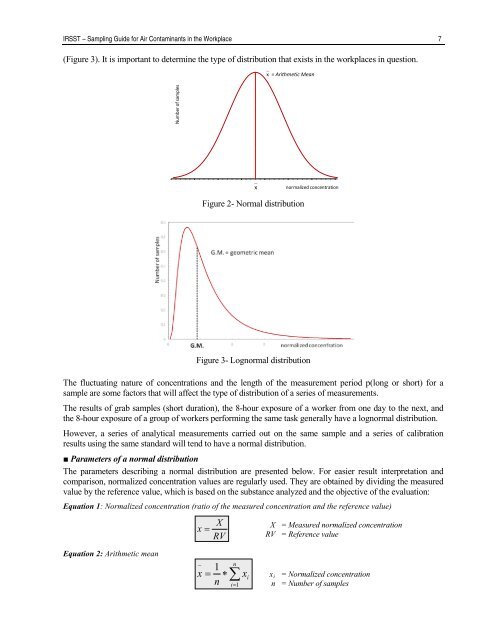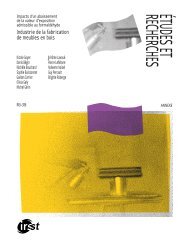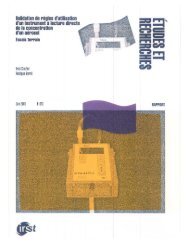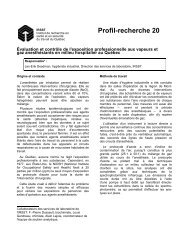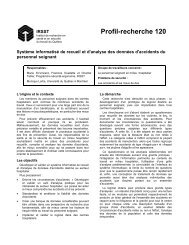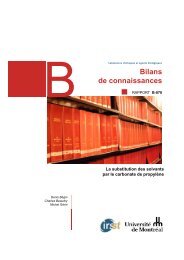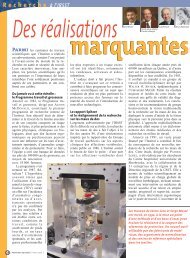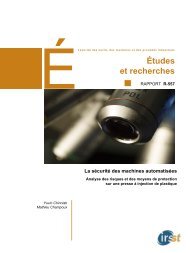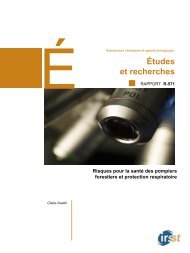Sampling Guide for Air Contaminants in the Workplace - Irsst
Sampling Guide for Air Contaminants in the Workplace - Irsst
Sampling Guide for Air Contaminants in the Workplace - Irsst
You also want an ePaper? Increase the reach of your titles
YUMPU automatically turns print PDFs into web optimized ePapers that Google loves.
IRSST – <strong>Sampl<strong>in</strong>g</strong> <strong>Guide</strong> <strong>for</strong> <strong>Air</strong> <strong>Contam<strong>in</strong>ants</strong> <strong>in</strong> <strong>the</strong> <strong>Workplace</strong> 7<br />
(Figure 3). It is important to determ<strong>in</strong>e <strong>the</strong> type of distribution that exists <strong>in</strong> <strong>the</strong> workplaces <strong>in</strong> question.<br />
⎺x = Arithmetic Mean<br />
Number of samples<br />
0,82 0,87 0,92 0,97 1,02 1,07 1,12 1,17<br />
⎺x<br />
Figure 2- Normal distribution<br />
normalized concentration<br />
Figure 3- Lognormal distribution<br />
The fluctuat<strong>in</strong>g nature of concentrations and <strong>the</strong> length of <strong>the</strong> measurement period p(long or short) <strong>for</strong> a<br />
sample are some factors that will affect <strong>the</strong> type of distribution of a series of measurements.<br />
The results of grab samples (short duration), <strong>the</strong> 8-hour exposure of a worker from one day to <strong>the</strong> next, and<br />
<strong>the</strong> 8-hour exposure of a group of workers per<strong>for</strong>m<strong>in</strong>g <strong>the</strong> same task generally have a lognormal distribution.<br />
However, a series of analytical measurements carried out on <strong>the</strong> same sample and a series of calibration<br />
results us<strong>in</strong>g <strong>the</strong> same standard will tend to have a normal distribution.<br />
■ Parameters of a normal distribution<br />
The parameters describ<strong>in</strong>g a normal distribution are presented below. For easier result <strong>in</strong>terpretation and<br />
comparison, normalized concentration values are regularly used. They are obta<strong>in</strong>ed by divid<strong>in</strong>g <strong>the</strong> measured<br />
value by <strong>the</strong> reference value, which is based on <strong>the</strong> substance analyzed and <strong>the</strong> objective of <strong>the</strong> evaluation:<br />
Equation 1: Normalized concentration (ratio of <strong>the</strong> measured concentration and <strong>the</strong> reference value)<br />
x =<br />
X<br />
RV<br />
X = Measured normalized concentration<br />
RV = Reference value<br />
Equation 2: Arithmetic mean<br />
−<br />
1<br />
x = ∗<br />
n<br />
n<br />
∑ x i<br />
i=<br />
1<br />
x i = Normalized concentration<br />
n = Number of samples


